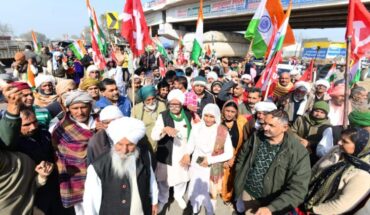To strengthen the agriculture sector, a provision of Rs.1.52 lakh crore has been made in the budget for agriculture and allied sector, out of which Rs.60,000 crore has been allocated for the Pradhan Mantri Kisan Samman Nidhi. Along with this, the government has indirectly made many provisions, which will brace the rural India.
The announcement of bringing 6 crore farmers and their land under the purview of land registry has been made in the budget. By the help of this, GIS mapping, digitization, ownership rights, registration of farmers and the identification of the land will be done. This will make the process easier for farmers to get the benefits of various government schemes.
Bio research has many benefits, such as, it will reduce the use of pesticides, reduce soil erosion, animal waste can be used in the fields as manure, etc. Therefore, it has been proposed to set up 10,000 bio research centres in the budget.
In the next 2 years, 1 crore farmers will start doing natural farming, which will also be branded and certified. Giving concrete shape to this initiative will help people stay healthy, since people fall sick more often due to the use of harmful chemicals in fertilizers. Synthetic chemicals are not used in natural farming, due to which there is more nutrition in food, which helps in keeping the body healthy. To strengthen the supply chain, large clusters will be developed near the consumption centres, which will stop the wastage of vegetables in villages, and they can be used optimally.
KCC was introduced in 1998 to provide credit to farmers based on their land holdings, so that farmers can easily buy seeds, fertilizers, pesticides etc. Further, in loan requirements, investment and non-agricultural activities were linked to it in 2004. Due to the great success of this scheme, KCC will be issued in 5 more states on extensive basis, where it is still not distributed among eligible farmers, so that farmers deprived of this facility can take advantage of this.
Digital Public Infrastructure (DPI) will be implemented in the agriculture sector to make farmers and their land a part of the digital network within 3 years. DPI creates a physical network, which is necessary for people to connect with each other and access various types of goods and services. The central government is currently running this concept as a pilot project in collaboration with the state government, but there is a proposal to implement this concept on the ground.
National Co-operation Policy will increase opportunities for banks to enter into loan agreements with co-operative societies. In this case, banks can increase the portfolio of Agri loans by entering into agreements with Farmer Producer Organisations (FPOs), co-operative societies and Agri startups. By entering into agreements or partnerships with them, banks will be able to understand the cash flow of farmers. This will encourage farmers to produce horticulture and other cash crops, because even now Indian farmers are doing farming in a traditional way.
A provision of Rs.86,000/- crore has been made in the budget for the Mahatma Gandhi National Rural Employment Guarantee Act (MGNREGA), under which adult members of each family willing to work will be provided employment for 100 days. During the Corona period, employment was provided to rural youth under MGNREGA, due to which they were successful in supporting themselves and their families.
The National Health Mission was launched in April 2005, which aims to ensure the availability of quality health facilities for children, women and underprivileged sections living in rural areas, since only a healthy person can improve productivity and upsurge economic activities. The government has made a provision of Rs.28,000/- crore for this initiative, which will improve the health of the villagers, enabling them to bring happiness & prosperity at home & society.
In India, farming is still dependent on monsoon. Equal irrigation facilities are not available across the country. At the same time, the crops of farmers are sometimes ruined by floods and sometimes by drought. In such a situation, the importance of crop insurance raises. Insurance works as a lifesaver for the farmer in difficult times. The bank gets the farmer’s crops insured, who have taken Kisan Credit Card (KCC) from the bank, but those who have not taken loan from the bank have to get their crops insured themselves. To ensure that farmers do not face financial problems in times of crisis, the government has made a provision of Rs.14,600/- crore in the crop insurance scheme.
Ayushman Bharat Yojana or Pradhan Mantri Jan Arogya Yojana (PMJAY) is a health scheme of the Government of India, which was implemented all over India on 23 September 2018. People belonging to Scheduled Caste, Scheduled Tribe category or a family in which there is no earning member above the age of 16 years or whose annual income is less than Rs.2.5 lakh per annum or listed in the PMJAY beneficiary list can take advantage of this scheme. This is dedicated to improving the health of the deprived or weaker sections of the society. Therefore, to ensure that maximum number of people can avail the benefits of this scheme, the government has made a provision of Rs.7,300/- crore in the budget.
The Pradhan Mantri Employment Generation Programme (PMEGP) scheme is being implemented through the Khadi and Village Industries Commission (KVIC), which acts as the nodal agency at the national level. PMEGP was started in 2008 by combining the Pradhan Mantri Rozgar Yojana and Rural Employment Generation Programme. It is a loan linked subsidy scheme, which is monitored by the Ministry of Micro, Small and Medium Enterprises (MSME). The objective of this scheme is to create new employment opportunities in rural and urban areas by promoting new self-employment related ventures, small enterprises and projects and to stop the migration of rural youth by making people economically self-reliant. A provision of Rs.2,300/- crore has been made in the budget to support this scheme.
In the year 2000, Prime Minister Shri Atal Bihari Vajpayee had launched the Pradhan Mantri Gram Sadak Yojana, under which the unpaved roads of villages were connected to the paved roads of cities. Now under the Pradhan Mantri Gramin Sadak Yojana, there is a plan to connect small and big villages to the paved roads of cities and to give it a concrete shape, a provision of Rs.19,000/- crore has been made in the budget.
Under the Pradhan Mantri Vishwakarma Yojana, banks are financing the craftsmen and artisans of the unorganized sector to make them economically self-reliant, so that they can be brought into the mainstream. The government has made a provision of Rs.4,800/- crore for consolidation of this scheme.
Farmers use fertilizers to increase the productivity of crops, in which a large part of the farmers’ income is spent. Therefore, to provide financial relief to the farmers, the government has proposed to give a subsidy of Rs.1.19 lakh crore in the purchase of urea, a kind of fertilizers, which is being used by the farmers on large scale in India for increasing productivity of their crops.
A large part of the population in our country is unable to get meal a day. To ensure that no person in the country remains hungry, a provision of Rs.2.05 lakh crore has been made in the budget for the Pradhan Mantri Garib Kalyan Anna Yojana (PMGKAY). Under this scheme, 81.35 crore beneficiaries will be provided 35 Kilogram and 5 Kilogram food grains as per their eligibility free of cost from January 1, 2024, for the next 5 years.
To continue the continuity of development in the rural area, it is necessary to ensure the availability of basic facilities in rural India. It seems that budgetary provisions will help in ensuring sustainable development in rural India.
Source-Budget Documents
Author : Shri Satish Singh is a senior columnist and has specialization in Banking and Economic subject. Currently, Shri Singh is working as an Assistant General Manager (Learning & Development) at the Local Head Office of Ahmedabad Circle of State Bank of India.






